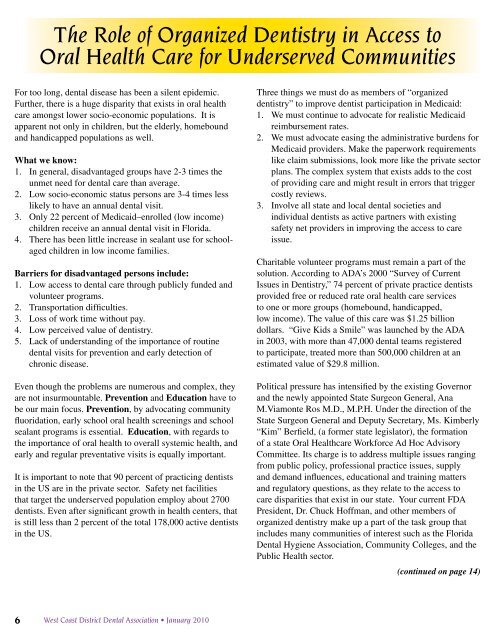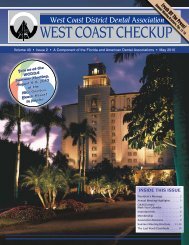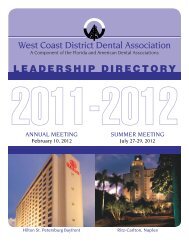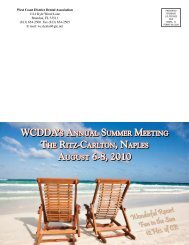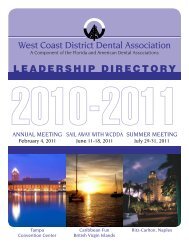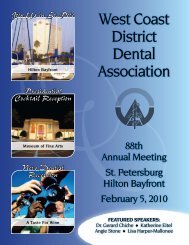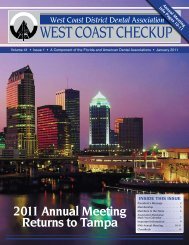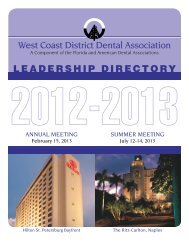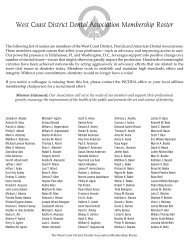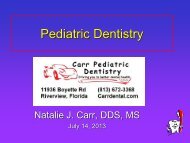Focus on St. Petersburg - West Coast Dental Association
Focus on St. Petersburg - West Coast Dental Association
Focus on St. Petersburg - West Coast Dental Association
Create successful ePaper yourself
Turn your PDF publications into a flip-book with our unique Google optimized e-Paper software.
The Role of Organized Dentistry in Access to<br />
Oral Health Care for Underserved Communities<br />
For too l<strong>on</strong>g, dental disease has been a silent epidemic.<br />
Further, there is a huge disparity that exists in oral health<br />
care am<strong>on</strong>gst lower socio-ec<strong>on</strong>omic populati<strong>on</strong>s. It is<br />
apparent not <strong>on</strong>ly in children, but the elderly, homebound<br />
and handicapped populati<strong>on</strong>s as well.<br />
What we know:<br />
1. In general, disadvantaged groups have 2-3 times the<br />
unmet need for dental care than average.<br />
2. Low socio-ec<strong>on</strong>omic status pers<strong>on</strong>s are 3-4 times less<br />
likely to have an annual dental visit.<br />
3. Only 22 percent of Medicaid–enrolled (low income)<br />
children receive an annual dental visit in Florida.<br />
4. There has been little increase in sealant use for schoolaged<br />
children in low income families.<br />
Barriers for disadvantaged pers<strong>on</strong>s include:<br />
1. Low access to dental care through publicly funded and<br />
volunteer programs.<br />
2. Transportati<strong>on</strong> difficulties.<br />
3. Loss of work time without pay.<br />
4. Low perceived value of dentistry.<br />
5. Lack of understanding of the importance of routine<br />
dental visits for preventi<strong>on</strong> and early detecti<strong>on</strong> of<br />
chr<strong>on</strong>ic disease.<br />
Even though the problems are numerous and complex, they<br />
are not insurmountable. Preventi<strong>on</strong> and Educati<strong>on</strong> have to<br />
be our main focus. Preventi<strong>on</strong>, by advocating community<br />
fluoridati<strong>on</strong>, early school oral health screenings and school<br />
sealant programs is essential. Educati<strong>on</strong>, with regards to<br />
the importance of oral health to overall systemic health, and<br />
early and regular preventative visits is equally important.<br />
It is important to note that 90 percent of practicing dentists<br />
in the US are in the private sector. Safety net facilities<br />
that target the underserved populati<strong>on</strong> employ about 2700<br />
dentists. Even after significant growth in health centers, that<br />
is still less than 2 percent of the total 178,000 active dentists<br />
in the US.<br />
Three things we must do as members of “organized<br />
dentistry” to improve dentist participati<strong>on</strong> in Medicaid:<br />
1. We must c<strong>on</strong>tinue to advocate for realistic Medicaid<br />
reimbursement rates.<br />
2. We must advocate easing the administrative burdens for<br />
Medicaid providers. Make the paperwork requirements<br />
like claim submissi<strong>on</strong>s, look more like the private sector<br />
plans. The complex system that exists adds to the cost<br />
of providing care and might result in errors that trigger<br />
costly reviews.<br />
3. Involve all state and local dental societies and<br />
individual dentists as active partners with existing<br />
safety net providers in improving the access to care<br />
issue.<br />
Charitable volunteer programs must remain a part of the<br />
soluti<strong>on</strong>. According to ADA’s 2000 “Survey of Current<br />
Issues in Dentistry,” 74 percent of private practice dentists<br />
provided free or reduced rate oral health care services<br />
to <strong>on</strong>e or more groups (homebound, handicapped,<br />
low income). The value of this care was $1.25 billi<strong>on</strong><br />
dollars. “Give Kids a Smile” was launched by the ADA<br />
in 2003, with more than 47,000 dental teams registered<br />
to participate, treated more than 500,000 children at an<br />
estimated value of $29.8 milli<strong>on</strong>.<br />
Political pressure has intensified by the existing Governor<br />
and the newly appointed <strong>St</strong>ate Surge<strong>on</strong> General, Ana<br />
M.Viam<strong>on</strong>te Ros M.D., M.P.H. Under the directi<strong>on</strong> of the<br />
<strong>St</strong>ate Surge<strong>on</strong> General and Deputy Secretary, Ms. Kimberly<br />
“Kim” Berfield, (a former state legislator), the formati<strong>on</strong><br />
of a state Oral Healthcare Workforce Ad Hoc Advisory<br />
Committee. Its charge is to address multiple issues ranging<br />
from public policy, professi<strong>on</strong>al practice issues, supply<br />
and demand influences, educati<strong>on</strong>al and training matters<br />
and regulatory questi<strong>on</strong>s, as they relate to the access to<br />
care disparities that exist in our state. Your current FDA<br />
President, Dr. Chuck Hoffman, and other members of<br />
organized dentistry make up a part of the task group that<br />
includes many communities of interest such as the Florida<br />
<strong>Dental</strong> Hygiene Associati<strong>on</strong>, Community Colleges, and the<br />
Public Health sector.<br />
(c<strong>on</strong>tinued <strong>on</strong> page 14)<br />
6 <strong>West</strong> <strong>Coast</strong> District <strong>Dental</strong> Associati<strong>on</strong> • January 2010


